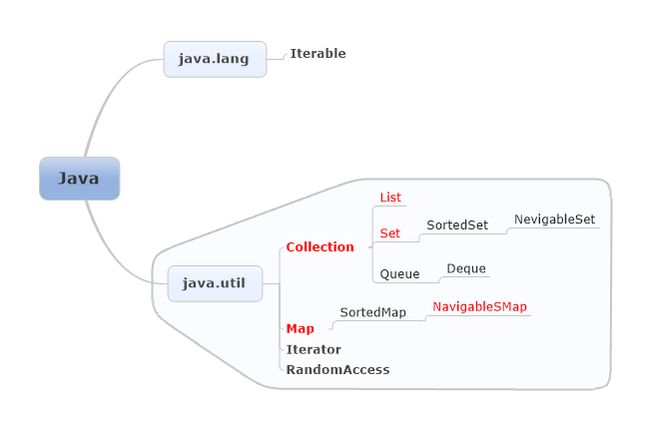Core Java (二十) Iterator,Iterable,Collection接口
Java集合类库将集合的接口与实现分离。同样的接口,可以有不同的实现。
Java集合类的基本接口是Collection接口。而Collection接口必须实现Iterator接口。
以下图表示集合框架的接口,java.lang以及java.util两个包里的。红色字体部分是OCJP考纲要求的接口。其他部分可以从左向右看,比如Collection的Subinterfaces有List,Set以及Queue等。
Iterator接口
Iterator接口包含三个方法:
public interface Iterator<E>{
E next();
boolean hasNext();
void remove();
}以下例子是利用了Iterator接口的着三个方法,实现遍历ArrayList<String>类型。
- 一开始迭代器在所有元素的左边,调用next()之后,迭代器移到第一个和第二个元素之间,next()方法返回迭代器刚刚经过的元素。
- hasNext()若返回True,则表明接下来还有元素,迭代器不在尾部。
- remove()方法必须和next方法一起使用,功能是去除刚刚next方法返回的元素。
package com.xujin;
import java.util.ArrayList;
import java.util.Collection;
import java.util.Iterator;
public class Test{
public static void main(String...arg){
Collection<String> a = new ArrayList<String>();
a.add("Bob");
a.add("Alice");
a.add("Lisy");
Iterator<String> iter = a.iterator();
while(iter.hasNext()){
String ele = iter.next();
System.out.print(ele + " ");//Bob Alice Lisy
}
System.out.println();
System.out.println(a);//[Bob, Alice, Lisy]
Iterator<String> iter2 = a.iterator();
iter2.next();
iter2.remove();
System.out.println(a);//[Alice, Lisy]
}
}
Iterable接口
Iterable接口仅包含一个方法:
public interface Iterable<E>{
Iterator<E> iterator();
}
for-each循环可以与任何实现了Iterable接口的对象一起工作。
Collection接口
此接口的方法
public interface Collection<E>{......}
| Modifier and Type | Method and Description |
|---|---|
boolean |
add(E e)
Ensures that this collection contains the specified element (optional operation).
|
boolean |
addAll(Collection<? extends E> c)
Adds all of the elements in the specified collection to this collection (optional operation).
|
void |
clear()
Removes all of the elements from this collection (optional operation).
|
boolean |
contains(Object o)
Returns true if this collection contains the specified element.
|
boolean |
containsAll(Collection<?> c)
Returns true if this collection contains all of the elements in the specified collection.
|
boolean |
equals(Object o)
Compares the specified object with this collection for equality.
|
int |
hashCode()
Returns the hash code value for this collection.
|
boolean |
isEmpty()
Returns true if this collection contains no elements.
|
Iterator<E> |
iterator()
Returns an iterator over the elements in this collection.
|
boolean |
remove(Object o)
Removes a single instance of the specified element from this collection, if it is present (optional operation).
|
boolean |
removeAll(Collection<?> c)
Removes all of this collection's elements that are also contained in the specified collection (optional operation).
|
boolean |
retainAll(Collection<?> c)
Retains only the elements in this collection that are contained in the specified collection (optional operation).
|
int |
size()
Returns the number of elements in this collection.
|
Object[] |
toArray()
Returns an array containing all of the elements in this collection.
|
<T> T[] |
toArray(T[] a)
Returns an array containing all of the elements in this collection; the runtime type of the returned array is that of the specified array.
|
实现Collection接口的每一个类都要实现以上众多方法,但开发者自己实现很麻烦。所以java提供了AbstractCollection类来编写具体的类。
以下类都实现了Collection接口:
AbstractCollection, AbstractList, AbstractQueue, AbstractSequentialList, AbstractSet, ArrayBlockingQueue, ArrayDeque, ArrayList, AttributeList, BeanContextServicesSupport, BeanContextSupport, ConcurrentLinkedDeque,ConcurrentLinkedQueue, ConcurrentSkipListSet, CopyOnWriteArrayList, CopyOnWriteArraySet, DelayQueue, EnumSet, HashSet, JobStateReasons, LinkedBlockingDeque, LinkedBlockingQueue, LinkedHashSet, LinkedList,LinkedTransferQueue, PriorityBlockingQueue, PriorityQueue, RoleList, RoleUnresolvedList, Stack, SynchronousQueue, TreeSet, Vector
Collection接口有三个常用的子接口,分别是List,Set,Queue。
